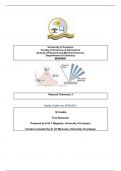Class notes
Comprehensive Study Guide for Atkins' Physical Chemistry (8th/9th Edition)
This study guide offers comprehensive coverage of Atkins' Physical Chemistry, focusing on the 8th or 9th edition of the textbook. It provides clear explanations, step-by-step solutions, and abundant examples to aid understanding of core concepts in thermodynamics, quantum mechanics, kinetics, and s...
[Show more]












